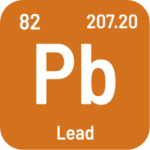Table of Contents
What is LEAD (Pb)?
 Lead (Pb, Latin: plumbum) is a heavy metal. It’s a relatively unreactive metal and is mainly found in minerals such as galena. In chemical compounds, it mainly occurs in the oxidation states +II and +IV.
Lead (Pb, Latin: plumbum) is a heavy metal. It’s a relatively unreactive metal and is mainly found in minerals such as galena. In chemical compounds, it mainly occurs in the oxidation states +II and +IV.
The importance of lead in seawater
Lead is one of the unwanted heavy metals that can have a negative impact on marine animals. This element serves no biological function and is toxic. Its presence in a saltwater aquarium indicates contamination with this element.
Dangers related to excess lead in seawater
The presence of lead in seawater is undesirable. High levels of it can lead to health problems for corals and other animals, and even their death.
How to protect your aquarium?
It’s important to regularly monitor the lead content and keep it at undetectable levels. The absence of lead in seawater ensures the health and vibrant coloration of marine animals. The most accurate and reliable method for determining lead is ICP-OES analysis. Inductively Coupled Plasma Optical Emission Spectrometry (ICP-OES) is the most precise analytical method for elemental composition analysis in seawater.
Recommendations
To maintain the appropriate level of lead in the aquarium, you should systematically monitor it.
If the lead level remains high for an extended period, it can lead to health problems for corals and other animals, and even their death. The most common causes of lead exceedance are:
- contaminated salt,
- green pigment in tubes or plastic elements,
- tap water,
- glass cleaners,
- frozen food.
Identify and eliminate the cause of the problem, then lower the value of this parameter in the water. Perform up to 6 water changes. It’s recommended to replace about 15% of the aquarium water volume during each change until the recommended value of this parameter is achieved. The replacement water must have the appropriate target salinity level. Use salt with the right parameters and composition suitable for conducting the ICP test.
Summary
The presence of lead (a heavy metal) in seawater poses a serious threat to most marine organisms, as even small amounts can harm animals. To protect marine animals in the aquarium from the negative effects of lead, it’s recommended to maintain its level at an undetectable value (0 μg/L), which ensures the health and vibrant coloration of animals.
About author

Magdalena Metzler
Privately, I am a mother and a lover of nature and sport. My main interest is quantum chemistry, which hides a whole lot of unsolved mysteries and connections, which is extremely exciting from a scientific point of view.
In my scientific career, I have conducted international projects focused on innovative solutions for many branches of business, e.g. automotive, construction, and now, of course, marine aquaristics.
Working at Reef Factory gave me a passion for marine aquaristics, which I can develop every day, building a chemistry department and creating products that will help aquarists take care of tanks and ensure the highest safety of animals. One of the most exciting memories of working at Reef Factory is the commissioning of the ICP-OES spectrometer, which analyzes the elemental composition of seawater. The method of analysis in ICP is based on an analytical technique, which is a combination of my passion for quantum chemistry and marine aquaristics.
I hope you find my articles on ReefPedia interesting and helpful! Happy reading :))

